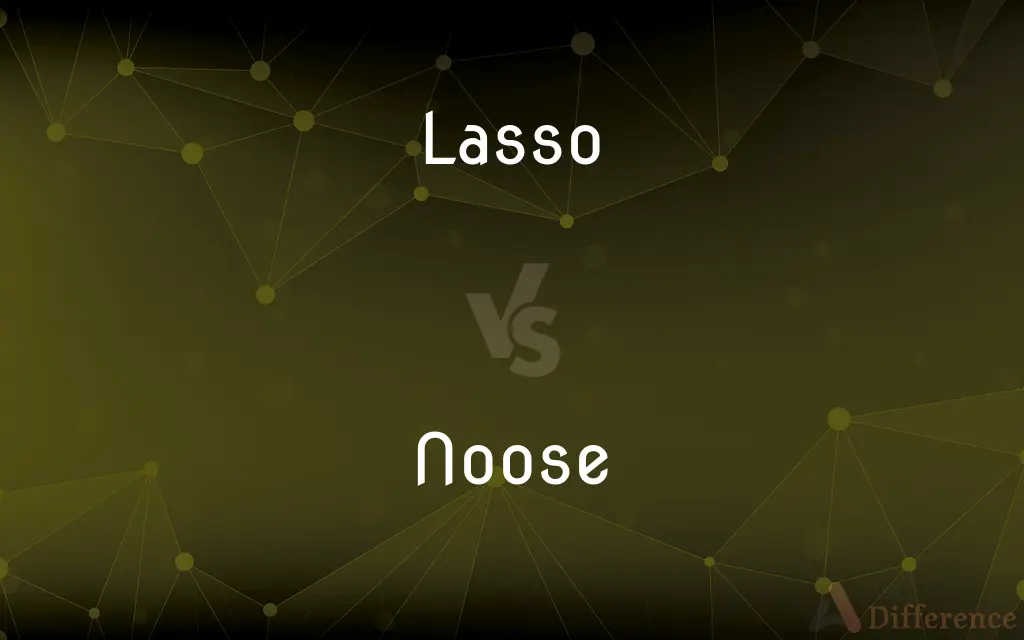Lasso vs. Noose — What's the Difference?
By Tayyaba Rehman & Urooj Arif — Updated on May 1, 2024
Lassos are ropes with a loop used primarily for capturing animals by cowboys, whereas nooses are knots designed to tighten under strain, often associated with hanging.

Difference Between Lasso and Noose
Table of Contents
ADVERTISEMENT
Key Differences
A lasso is a tool used in rodeos and ranch work, typically made of a length of rope with a sliding loop at one end. Whereas a noose is a type of knot that can secure itself under tension, and is notorious for its use in executions and suicide.
Lassos are crafted to be thrown and tightened around a target such as cattle or horses, facilitating capture without harm. On the other hand, nooses are designed to tighten as the load increases, making them effective in trapping or hanging.
The technique for using a lasso involves swinging it in a large circle before releasing it to ensnare the intended animal. In contrast, nooses are generally fixed in place and tighten when the intended load moves or falls.
Lassos are integral to the culture of cowboys and are seen as tools of skill and control. Whereas, nooses carry a grim association with death and are often seen in a negative light due to their historical and controversial use.
In terms of construction, a lasso is made from stiff, yet flexible materials to maintain an open loop when thrown. Meanwhile, a noose can be made from almost any type of rope but requires a specific knot that allows the loop to tighten under pressure.
ADVERTISEMENT
Comparison Chart
Primary Use
Capturing animals
Tightening under load, often for hanging
Knot Type
Running noose that can be easily adjusted
Fixed noose that tightens and secures
Technique
Thrown by hand
Set up and triggered
Material
Stiff, flexible ropes to maintain open loop
Any rope suitable for the knot
Cultural Connotation
Associated with cowboy culture
Often viewed negatively due to historical context
Compare with Definitions
Lasso
A tool of the cowboy and rodeo culture.
His skill with the lasso was well known throughout the west.
Noose
A loop with a running knot, tightening as the rope is pulled.
The noose was set as a trap for the wild boar.
Lasso
To catch or entangle with a lasso.
She lassoed the horse with precision.
Noose
A knot used in various practical applications beyond executions.
The sailor used a noose knot to secure the cargo.
Lasso
A rope with a noose at one end, used especially for catching livestock.
The cowboy expertly threw the lasso around the fleeing calf.
Noose
Associated with executions by hanging.
Historical uses of the noose cast a shadow on its perception.
Lasso
A method involving skill and timing.
Lassoing requires more technique than brute force.
Noose
A symbol of death and mortality in various cultures.
In literature, the noose often symbolizes inevitable fate.
Lasso
A symbol of control and capture.
The lasso hung on the barn wall, a testament to decades of ranch work.
Noose
Used metaphorically to describe a tight grip or control.
The new regulations felt like a noose tightening around our freedoms.
Lasso
A lasso ( or ), also called lariat, riata, or reata (all from Castilian, la reata 're-tied rope'), is a loop of rope designed as a restraint to be thrown around a target and tightened when pulled. It is a well-known tool of the Spanish and Mexican cowboy, then adopted by the cowboys of the United States.
Noose
A noose is a loop at the end of a rope in which the knot tightens under load and can be loosened without untying the knot. The knot can be used to secure a rope to a post, pole, or animal but only where the end is in a position that the loop can be passed over.
Lasso
A long rope with a running noose at one end, used especially to catch horses and cattle. Also called lariat.
Noose
A loop with a running knot, tightening as the rope or wire is pulled and used to trap animals or hang people
A hangman's noose
He began to choke as the noose tightened about his throat
The West is exploring ways to tighten the economic noose
Lasso
To catch, tie, or attach with or as if with a lasso.
Noose
Put a noose on (someone)
She was noosed and hooded, then strangled by the executioner
Lasso
A long rope with a sliding loop on one end, generally used in ranching to catch cattle and horses.
Noose
A loop formed in a rope by means of a slipknot so that it binds tighter as the rope is pulled. Also called running noose.
Lasso
(computing) An image-editing function allowing the user to capture an irregularly-shaped object by drawing an approximate outline.
Noose
A snare or trap.
Lasso
(transitive) To catch with a lasso.
Noose
To capture or hold by or as if by a noose.
Lasso
A rope or long thong of leather with a running noose, used for catching horses, cattle, etc.
Noose
To make a noose of or in.
Lasso
To catch with a lasso.
Noose
An adjustable loop of rope, such as the one placed around the neck in hangings, or the one at the end of a lasso.
Lasso
Belgian composer (1532-1594)
Noose
(transitive) To tie or catch in a noose; to entrap or ensnare.
Lasso
A long noosed rope used to catch animals
Noose
A running knot, or loop, which binds the closer the more it is drawn.
Lasso
Catch with a lasso;
Rope cows
Noose
To tie in a noose; to catch in a noose; to entrap; to insnare.
Noose
A trap for birds or small mammals; often has a noose
Noose
A loop formed in a cord or rope by means of a slipknot; it binds tighter as the cord or rope is pulled
Noose
Make a noose in or of
Noose
Secure with a noose
Common Curiosities
How is a noose different from other knots?
A noose is designed to tighten under strain, making it unique compared to knots that secure without tightening.
What are the ethical concerns associated with nooses?
Nooses are controversial due to their historical association with executions and racial violence.
Can a lasso be used for purposes other than livestock?
Yes, lassos can also be used in sports like rodeo events and for training animals.
Are there safety precautions to consider when using a noose?
Yes, due to its potential for injury or death, it’s important to handle a noose with extreme care.
How do you properly maintain a lasso?
Maintain a lasso by keeping it clean, dry, and coiled when not in use to preserve its flexibility and durability.
Can nooses be used in survival situations?
Yes, nooses can be used in survival situations for trapping animals or securing gear.
Are there any similarities between a lasso and a noose?
Both involve a loop of rope, but their uses and connotations differ significantly.
What is the primary use of a lasso?
Lassos are primarily used to catch and control livestock.
Is there a cultural significance to the lasso in America?
Yes, the lasso has a significant cultural presence in American cowboy and rodeo traditions.
What materials are best for making a noose?
Durable, flexible rope that can tighten effectively is best for making a noose.
What are the legal implications of possessing a noose?
In some regions, possessing a noose can have legal implications, especially if used or displayed in threatening manners.
How is a noose knot tied?
A noose knot is tied by creating a loop in the rope and then wrapping the end around itself multiple times before pulling it tight.
What skills are required to use a lasso effectively?
Skills needed include accuracy, timing, and an understanding of animal behavior.
How does the public generally perceive lassos?
Lassos are generally viewed positively, especially in contexts related to traditional ranching and rodeo.
Can nooses have applications in activities like climbing or boating?
Yes, nooses can be adapted for practical uses in climbing, boating, and other activities where securing a load is necessary.
Share Your Discovery

Previous Comparison
Baseband vs. Passband
Next Comparison
Forgiveness vs. PardonAuthor Spotlight
Written by
Tayyaba RehmanTayyaba Rehman is a distinguished writer, currently serving as a primary contributor to askdifference.com. As a researcher in semantics and etymology, Tayyaba's passion for the complexity of languages and their distinctions has found a perfect home on the platform. Tayyaba delves into the intricacies of language, distinguishing between commonly confused words and phrases, thereby providing clarity for readers worldwide.
Co-written by
Urooj ArifUrooj is a skilled content writer at Ask Difference, known for her exceptional ability to simplify complex topics into engaging and informative content. With a passion for research and a flair for clear, concise writing, she consistently delivers articles that resonate with our diverse audience.
















































